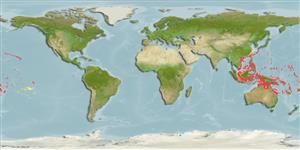Common names from other countries
>
Acanthuriformes (Surgeonfishes) >
Acanthuridae (Surgeonfishes, tangs, unicornfishes) > Acanthurinae
Etymology: Zebrasoma: Derived from Zebra = African horse + Greek, soma = body; referring to the stripes (Ref. 45335).
More on author: Bennett.
Environment: milieu / climate zone / depth range / distribution range
Sinh thái học
Biển Cùng sống ở rạn san hô; Mức độ sâu 2 - 46 m (Ref. 9710), usually 3 - 46 m (Ref. 27115). Tropical; 24°C - 28°C (Ref. 27115); 30°N - 25°S, 105°E - 137°W
Pacific Ocean: Ryukyu, Mariana, Marshall, Marcus, Wake and Hawaiian islands. Has been reported off the coast of Florida in the Western Central Atlantic (Ref. 51238).
Length at first maturity / Bộ gần gũi / Khối lượng (Trọng lượng) / Age
Maturity: Lm 6.3 range ? - ? cm
Max length : 20.0 cm TL con đực/không giới tính; (Ref. 9710)
Các tia vây lưng cứng (tổng cộng) : 5; Các vây lưng mềm (tổng cộng) : 23 - 26; Tia cứng vây hậu môn: 3; Tia mềm vây hậu môn: 19 - 22. bright yellow overall (pale in preservative). Sheath of peduncular spine white. Body very deep, its depth 1.4 to 1.75 times in SL. Snout moderately protruding. Mouth small; teeth spatulate, close-set, the edges denticulate. 12 upper and 14 lower teeth in juveniles, and 18 upper and 22 lower teeth in an adult 15 cm SL (Ref 9808).
Adults inhabit coral-rich areas of lagoon and seaward reefs from below the surge zone to about 46 m (Ref. 9710). Benthopelagic over rock at 1-81 m (Ref. 58302). They occur singly or in loose groups. Mainly herbivorous, browsing on filamentous algae. Group spawning and pair-spawning by territorial males that court passing females were observed. Spawning activity occurs around the full moon indicating lunar periodicity (Ref. 86544). Spawn in batches throughout the year (Ref. 86544). Presence of a venom gland could not be determined despite the presence of distinct anterolateral grooves; this may be due to the loss of venom glands in adults (Ref. 57406). A popular aquarium fish and the top marine fish export from Hawaii.
Paired spawning (Ref. 240). Multiple spawner with reproductive activity occuring around the full moon (Ref. 86544).
Myers, R.F., 1991. Micronesian reef fishes. Second Ed. Coral Graphics, Barrigada, Guam. 298 p. (Ref. 1602)
IUCN Red List Status (Ref. 130435)
CITES (Ref. 128078)
Not Evaluated
Threat to humans
Harmless
Human uses
Các nghề cá: Tính thương mại; Bể nuôi cá: Tính thương mại
Các công cụ
Special reports
Download XML
Các nguồn internet
Estimates based on models
Preferred temperature (Ref.
115969): 24.9 - 28.9, mean 27.6 (based on 614 cells).
Phylogenetic diversity index (Ref.
82804): PD
50 = 0.5078 [Uniqueness, from 0.5 = low to 2.0 = high].
Bayesian length-weight: a=0.01950 (0.01203 - 0.03160), b=2.98 (2.84 - 3.12), in cm Total Length, based on LWR estimates for this species & (Sub)family-body (Ref.
93245).
Mức dinh dưỡng (Ref.
69278): 2.0 ±0.00 se; based on food items.
Thích nghi nhanh (Ref.
120179): Chiêù cao, thời gian nhân đôi của chủng quần tối thiểu là dưới 15 tháng (K=0.25; Fec > 10,000).
Fishing Vulnerability (Ref.
59153): High vulnerability (57 of 100).
